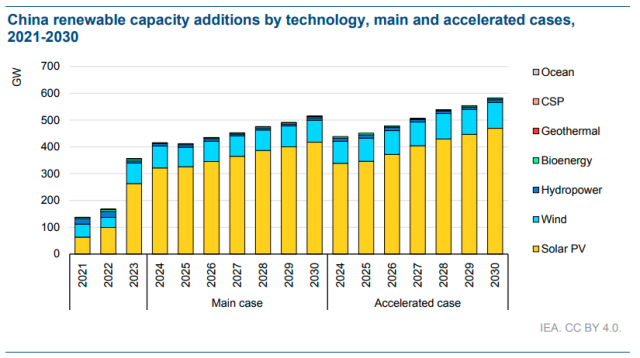China is set to expand its renewable energy capacity by nearly 3,207 GW from 2024 to 2030, tripling the growth seen in the previous six years, according to the International Energy Agency (IEA).
Annual renewable energy additions are projected to surpass 500 GW by 2030, with solar photovoltaic (PV) accounting for 80 percent of this increase. This rapid growth has already seen China surpass its 2030 target of 1,200 GW of solar PV and wind capacity six years ahead of schedule, hitting the milestone in July 2024.
China’s solar PV manufacturing capacity has surged since 2022, significantly outpacing both domestic and global demand. This overcapacity has pushed module prices down, making solar PV more competitive with regulated power prices. While this benefits local deployment, trade measures are slowing growth in export markets, further emphasizing the need for a robust domestic PV market to absorb the excess supply.
Since the phaseout of central government subsidies, China has transitioned to long-term power purchase contracts for wind and solar PV developers, set at provincial benchmark electricity prices largely defined by coal-fired power generation.
Despite the discontinuation of the feed-in-tariff policy in 2020, China’s solar PV capacity nearly tripled to 261 GW by 2023. New utility-scale solar PV and onshore wind installations now have lower generation costs than coal-fired facilities in most provinces, contributing to an optimistic renewable energy outlook.
The IEA’s forecast projects that China’s total variable renewable capacity will reach 4,225 GW by 2030, though the growth rate of solar PV additions is expected to slow. The forecast has been revised up by 24 percent from 2023, reflecting several key trends. The oversupply of solar PV modules has driven costs down, and falling interest rates since January 2023 have further improved solar PV’s competitiveness against coal-based electricity.
Additionally, recent power market reforms and green certificate systems have enabled developers to access more attractive prices than those offered by regulated contracts. In provinces where local wholesale markets trade more power, electricity prices are higher, boosting the profitability of renewable projects. China’s Whole County PV pilot policy, which mandates a percentage of rooftops to be equipped with PV panels, along with rising retail electricity prices in 2023, has also spurred rapid commercial and industrial solar deployment.
However, the rapid expansion of solar PV and onshore wind has created significant grid integration challenges. Curtailment of utility-scale solar PV and wind is rising in northern and northeastern provinces, straining the economics of new projects. Transmission grid constraints and growing distribution grid challenges, especially with the addition of 180 GW of commercial and residential PV capacity since 2021, are expected to impact the bankability of future projects.

